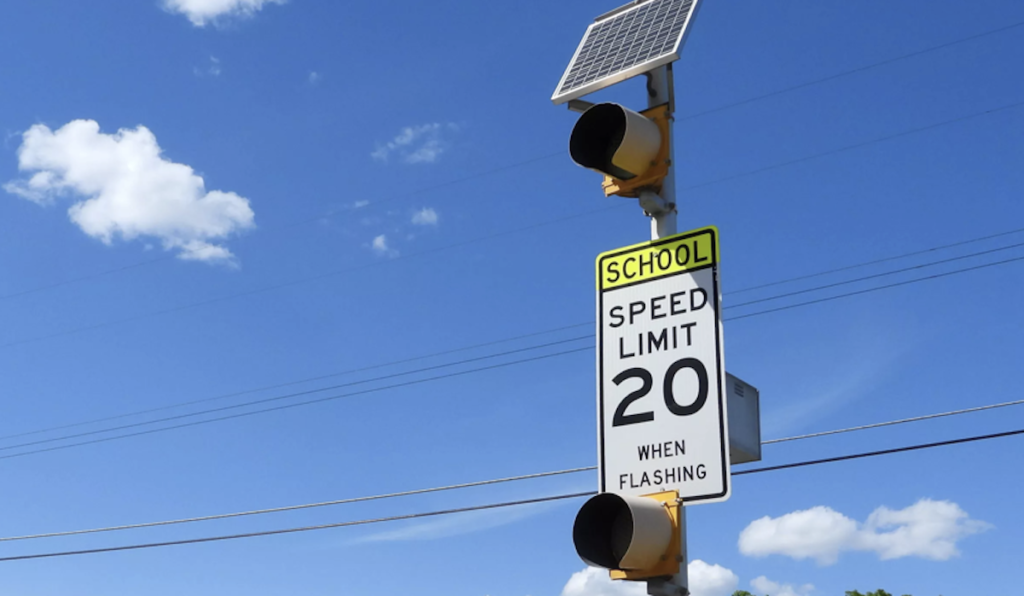
Ahead of the reactivation of South Fulton’s school zone cameras on Aug. 8, motorists in the area are being encouraged to slow down.
South Fulton first launched the Ren’gia Majors School Zone Safety Program in 2019. Majors, an 11-year-old Sandtown Middle School student, was killed in 2018 in a traffic accident in front of the school. Cameras now monitor speeds in 14 school zones throughout the city.
City officials partner with Blue Line Solutions to manage the program. The number of cars traveling through South Fulton school zones has been reduced by approximately 25,000 annually, and the number of tickets issued has also substantially decreased.
Following Georgia law, the school zone cameras monitor speeds and issue citations during the regular school day on weekdays. For an hour before and after students arrive at and leave school, a speed limit of 25 mph is in effect in all school zones. Flashing lights should alert drivers to those times.
During the rest of the day, drivers must follow posted speed limits, which vary among the school zones. Drivers caught speeding are fined $100 for first offenses and $150 for subsequent violations.
“If the lights are flashing, keep your speed at 25 mph or under,” said Police Chief Keith Meadows. “At all other times, follow the posted limits. To put it simply, just slow down.”
Meadows pointed out that while the system does not issue citations outside of school hours, motorists are subject to traffic stops by patrol officers. In addition, police officials use data gathered by the cameras 24 hours a day to determine where extra patrols are needed.
Speeding in school zones is an issue statewide, not just in South Fulton. Over the last decade, nearly one-third of child pedestrian fatalities occurred between 3 and 6 p.m.
AAA launched the School’s Open Drive Carefully awareness campaign in an effort to prevent school-related child pedestrian traffic crashes. Spokespersons for the campaign offer several tips for motorists in an effort to save young lives.
- Slow down. Speed limits in school zones are reduced for a reason. A pedestrian struck by a vehicle traveling 25 mph is nearly two-thirds less likely to be killed compared to a pedestrian struck by a vehicle traveling just 10 mph faster. A difference between 25 mph and 35 mph can save a life.
- Eliminate distractions. Children often cross the road unexpectedly and may emerge suddenly between two parked cars. Research shows that taking your eyes off the road for just two seconds doubles your chances of crashing.
- Reverse responsibly. Every vehicle has blind spots. Check for children on the sidewalk, driveway and around your vehicle before slowly backing up. Teach your children to never play in, under or around vehicles—even those that are parked.
- Talk to your teen. Car crashes are one of the leading causes of death for teens in the United States, and more than one-quarter of fatal crashes involving teen drivers occur during the after-school hours of 3 to 7 p.m.
- Come to a complete stop. Research shows that more than one-third of drivers roll through stop signs in school zones or neighborhoods. Always come to a complete stop, checking carefully for children on sidewalks and in crosswalks before proceeding.
- Watch for bicycles. Children on bicycles are often inexperienced, unsteady and unpredictable. Slow down and allow at least three feet of passing distance between your vehicle and the bicycle. If your child rides a bicycle to school, require that they wear a properly fitted bicycle helmet on every ride.
“If parents and other driver’s follow these simple rules when driving in and around schools zones, countless children can avoid injury and death,” said Garrett Townsend, Georgia Public Affairs Director, AAA-The Auto Club Group. “It’s up to us to help all drivers become more aware of the risks of driving around our schools.”
Have news to share with South Fulton residents? Email us at [email protected]. Plus follow us on Facebook, Instagram and Twitter @cosfobserver.
